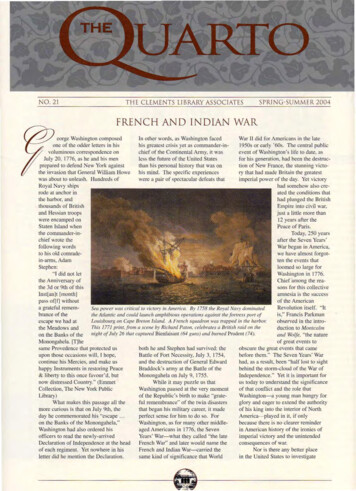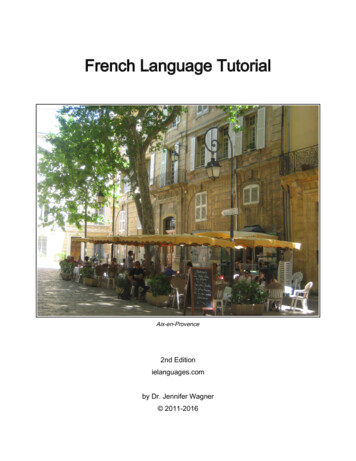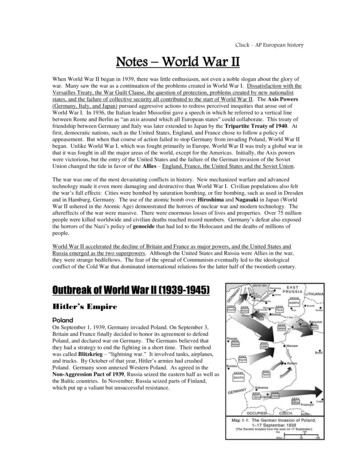
Transcription
NO. 21THE C LE MENTS LI BRARY ASS OC IATE SSPRING-SUMMER 2004FRENCH AND INDIAN WARWar II did for Am eric ans in the lateeorge Washi ngton composedIn other words. as Washington facedI950s or early ' 60s . Th e cen tra l pub licone of the odder letters in hishis greates t cris is ye t as co mm ander-involuminou s co rrespo nde nce onevent of Washington 's life to date, aschief of the Continental Arm y. it wasless the futu re of the United StatesJul y 20, 1776, as he and his menfor his gene ration, had been the destru cprepared to defend New York aga instthan his personal hi story that was ontio n of New France. the stunning vic tothe invasion that Ge nera l \Villi am Howehis mind. Th e specific experie ncesry that had mad e Britain the grea testwere a pair of spec tacular defeats thatimperi al po we r of the day. Yet victorywas abo ut to unlea sh. Hundreds ofhad somehow also cre Royal Navy shipsrode at anchor inate d the con ditions thatthe harbo r, andhad plunged the Britishthousands of Br itishEmp ire into civil war,and Hessian troopsjust a little mor e thanwere encamped on12 years after thePeace of Paris.Staten Island whe nthe co mmande r-inTod ay, 250 yearschief wro te theafte r the Seven Years'War be gan in Ameri ca.following wordsto his old comra dewe have almost forgotten the eve nts thatin-arms . Adamloomed so large forStephen :"I did not letWashin gton in 1776.the Anniversary ofChi efam ong the rea so ns for this co llec tivethe 3d or 9th of thisamne sia is the succes sInstj an]t [mo nth]of the Americanpass of[ f] withoutRevo lution itself. "Ita gr ateful rem emSea power was critical to victory' in America. B.1/ /758 the Royal Navy dominatedbrance of theis," Francis Parkmanthe At lanti c and could launch amphibious operations against the fort ress port ofLauisbourg on Cape Brehm Island. A French squadron was trapped ill the ha rbor.ob served in the intro escape we had atThis 1771 pr int, from a scene by Richard Pato n. celebrates a British raid on theducti on to Montca lmthe Meadows andnight of luly 26 that captu red Bienfaisant (64 Ijll ll S) lind burned Prudent (74).and V ) lfe . "the natureon the Ban ks of theMonon gahela. [T jheof great events tosa me Pro vedence that protected usobsc ure the great events that cameboth he and Stephen had survive d: theupon those occasion s will, I hope,before them." Th e Seven Years ' WarBattle of Fort Necess ity, Ju ly 3, 1754 ,co ntinue his Mercies, and make usand the de structi on of General Edwardhad , as a result. been " half lost to sigh thappy In struments in resto ring Peacebeh ind the storm -clo ud of the War o fBraddock 's army at the Battle of theMonon gahel a on J uly 9, 175 5.Indepe ndence ." Yet it is important for& liberty to this once favour' d, butus today to understan d the significancenow distressed Cou ntry: ' (Emm etWhi le it may puzzle us thatColl ec tion, The New York Publi cWashington pa used at the very momentof that con flict and the ro le thatLibrary )Washington - a young man hungry forof the Rep ubli c 's birt h to make "gr ateful remem bra nce" of the twi n di sa stersglory and eager to extend the authorityWh at makes this passage all theo f hi s king into the interi or of No rthmore curio us is that on J uly 9th, thethat began his military ca ree r, it madeday he com me morated his "escape .perfect sense for him to do so. ForAm erica- played in it, if onlybeca use there is no clearer reminderon the Banks of the Monongahela ,"Washington, as for many oth er middleaged Am eri can s in 1776, the Sev enin A merican history of the iron ies ofWashington had also ord ered hisYears ' War- wh at they called "the lateimperial victory and the un intendedofficers to re ad the newly-arrivedFrenc h War" and later wo uld name theco nsequences of war.Declaration of Independence at the headFrench and Indian War-carri ed theNor is there any be tter placeof each regiment. Yet nowh ere in hislett er did he mention the Declarat ion.same kind of significa nce that Worldin the United States to inve stigate-- - - -i}f----
European milita ryforces encountered Native Americans as both allie s und enemies. A cartoucheitlustration. fr om Thomas Hutchins 's map of the Ohio CO U Ilt1) depicts CJ /764 council between ColonelHenry Bouquet and local Indians. Additional details include a rare image of a Scottish soldier (left)and a milita ry encampm ent.the historical experience. and even the look.of the Seven Years' War than the ClementsLibrary. Benjamin West' s 'T he Death ofGeneral Wolfe" -his third rendition of thescene. completed in I776--hangs over theelegant Main Room in solemn glory. It isonly the most visible treasure in an unmatchedcollection of books , maps. images, and manuscripts relating to the war in America.Engravings. like a colored mezzotint from1771 depicting the capture of the Frenchline-of-battle ship Hienfaisant at the siegeof Louisbourg in July 1758, capture the dramaof military events. Other prints-notablythe twenty-eight plates of the Sceno graphiaAmericana: Or, a Collection of Vie ws inNorth America and th e West Ind ies . . .From Dra wings taken on the Spot, by SeveralOfficers of the British Navy and Armyshow contemporary views of cities and forts,seascape s and landscapes, and communicatethe fascination of British subjects with theexotic locales in which the war was fought.If these images hint at the exultation of theBritish in the greatest military victoryof their history, thc Gage Papers and othermanuscripts. including the diaries of commonsoldiers, speak with equal power of the grinding daily realities of the war experie nce andthe terrors of battle.What remains largely unseen in theimages of the war, although not in the grittierworld depicted in the manuscripts and maps,are those aspects of the conflict and its meaning that modern Americans might most profitably contemplate on the 250th anniversaryof its beginning. In bringing to an end theFrench empire in North America, the SevenPAGE 2Years' War undermined, and ultimatelydestroyed, the ability of native peoples to resistthe expansion of Anglo-American settlement.The war 's violence and brutality, moreover,engendered attitudes and patterns of behavioron the frontier that encouraged whites to hateIndians as they had never been able to do inthe pre-war world. In that earlier time of competition between empires. colonists had beenrequired to make distinctions between friendlyand hostile groups, if only because their sur-vival had depended upon it. These new, indiscriminate attitudes, soon to be reinforced by thebitter experience of the War of Independenceon the northern and western frontiers, helpedcreate the foundations of an American culturaland political identity separate from the olderBritish one. even as they promoted and justified the annihilation of whole Indian peoplesin the name of freedom. civi lization, and peace.In that sense, the story of the SevenYears' War is much more than a phase in theearly military career of George w ashingtonand more than a prelude to the AmericanRevolution with which we are familiar- thestruggle for liberty against oppression, rightsagainst power, independence against subjugation. It is also a darker story, one in which thevery realization of imperial ambitions producesunpredictable results: in which victory breedsdisaster for the victor; in which the evidentlybenign growth of a population of peaceablefarmers leads to the wholesale destruction ofnative peoples. Those are as much a part ofAmerican history as the brighter. more familiar,more comfortable story of rights defended andliberty maintained. The fact that both storiesmeet in the person of George Washington isworth thinking about as we seek to understandthe causes. character. and consequences of awar that no one wanted but which transformedtheir world forever.-Fred AndersonProf essor of HistoryUniversity of Colorado, BoulderDrawings by mili tary and naval officers were the basis fo r the plates q{ Sccnographia Americana,publish ed ill / 768. MallY combin e wartime events with dramatic scenery. This is Cap Rouge onthe St. Lawrence River, nine miles above Quebec. drawn by Captain Hervey Smyth.THE Q1/ARTO
A CON FLICT DOCUMENTEDred Anderson , whoprovides the introdu ction to thi s issue of theQuarto, is the author ofCrucible of War: The SevenYears' War and the Fate of Emp ire in BritishNorth America, /754-/766 (New York, 2( 00).His comprehensive study is one of the mo strecent of many works to draw on the richresources of the Clement s Library documentin gthe contl ict most America ns still think of as theFrench and Indian War. Primary source mat erial for the Seven Years' War in Am erica may befound throughout the collec tions. Thi s reflectsthe focus of William L. Clements, amon gwhose many interests was the era of theAmerican Revolution and the eve nts thatled to it. An early strength of the Library,the period of the Seven Years' War rem ain sa collecting priority as we reach the 250thanniversary of the beginning of fighting inthe for ests of western Penn sylvania.The holdin gs of the Clements Libraryare typicall y diver se on this period of Ameri canhistory. Our Book Di vision ha s copies ofAmeri can and Briti sh political imprints of thetime, magazines, sermons relating to the war,narratives justifying territorial claims of thecomp eting po wers, military texts, historie swritt en soo n after the war, and much moreprinted materi al. The Map Division hold s h undreds of printed maps illuminating the militaryor politi cal situation. There are dozens of man uscript map s and plans and hundreds more represented by facsimiles of originals from othercollections. The Graphics Di vision containsportr ait prin ts of participants, cartoons, andengra vings of even ts, topography, and citiesproduced from dra wings sent back to Europeby participant s in the war.The Manuscript s Division isparticularly rich in unique colle ctions thatdocument the confl ict at man y different levels.Description s of these collections are accessiblethrough the Clements Libr ary web site(www.clements.umic h.edu). but a revie wof them will give some idea of thei r scopeand perhaps whe t the ap petite of scholars whowish to cons ult them durin g the co ming years.Th e collections have been gro uped into roughcategories, though most are likel y to containdocumentation on a variety of subjects .Italics indica te the nam es under whichcollections will be found on the web site.The War in America: Festering NorthAmerican boundary disputes helped lay thepowder train for war, and the Lib rary has theletterbook s and pap ers of William Mildmay,one of the British commissi oners appointed todetermine the bound aries of Ac adia. A recentacquis ition also relates to the begi nning of theconflict. Sometime in 1757 an Americancolonis t, prob abl y Virginia provincial officerWilliam Trent, drew on his own experienc es toprepare a ten-page cri tiq ue of a French accountof the earl y eve nts of the war in westernPennsylvan ia . He discu sses the French seizureLower levels of command may beglimpsed in the Browne Brothers Papers,the corre sponde nce of lieutenants Richardand Franci s Browne , who describe, respectively, eve nts in Germany and in No va Scoti a. theWest Indi es, and Cuba. The sinews of the warare reveal ed in the James Furnis Letterbook of1755-58 containing the writings of an officerwho served as commissary of stores and pay master in Albany and later comptroller of ordnance in North Am eri ca. The MiscellaneousJohn HI: Oglelthorpe served on the successjitl/758 expedition agains t Fort D uquesne. Upon his return,in January 1 759, he descr ibed his experiences to Samuel \1}'ly and included a sketch of the ruins of theFrench fort. Hy ly fo r. arded the letter to South Carolina Govern or William Henry Lyttelton, in whosepapers it surv ives.of the Forks of the Ohio and the defeat ofGeor ge Washington at Fort Neces sity. Anoth ermanu script narrative, Jean Chaton's "Hisroireabregee de la co nquctc du Canada," pro videsan accoun t of the Brit ish conquest of thecolony.Th e perspective of a senior Briti shofficer is represented in the papers of ThomasGage, who fought as a regi mental com manderand brigadi er. His papers are most useful forhis comm and at Albany and Oswego in 1759,the conques t and occupation of New Francein 1760-63, and the progress of Pon tiac 's Warin 1763-64. Complementing Gage 's paper s aresome of Jeffery A mh e rst's, who commandedin Americ a from 175 8 to 1763. These containsome deta ils on the French and Indian War andmuch on the sub sequent Indian uprising . TheLibrary is also fortunate to ha ve the papers andlette rboo ks of William Henry Lyttelton, governor of South Carolina from 1755-60 andJamaica from 1760-66. Th ese are excepti onally rich in inter-colonial correspondence andsouthern Indi an affairs,Collec tion contains a variety of letters anddocu ment s relating to the war, including correspondence of Sir William John son , WilliamEyre, Thomas Po wnall, and others. Additionalmiscellaneous letters relating to the co urse ofthe war are in the Howe Brothers Papers andthose of Charles Townshend.World War: Other Clements Librarycollections contain corres ponde nce and documents concerning the war at sea and in Europe.The Ligonier Letterbook of 1758-60 has m uchon army affair s in the co rrespo ndence ofLord John Ligonier, commander-in-chi efund er Prim e Mini ste r William Pitt . Politicsand early military actions are dis cussed in 62letters in the George Grenville Papers. Furthercorres ponde nce concerning the pro gre ss of thewar occurs in the George Germain and Earl ofShelburne Pape rs. The Shelburne Papers alsocontained man usc ript maps from both theAmerican and European theaters.Although the papers of Henry Clintonare known for their extensive documentationof the American Revoluti on , a par t of themTHE Q1JARTOPAGE 3
pertains to his service inas a provincial chaplainat Fort Edward in 1756Europe as aide-de-campto Lord Ligonier and theand Havana in 1762.Jona than French wasDuke of Brunswick. TheFrederick Mackenzieanother MassachusettsPapers also focus on thesoldie r at Fort EdwardAmer ican Revolution.in 1757. Samu el M orrisbut one volume has hisserved in the disastrouscompilation of articles ofcampaign againstcapitulation for fortre ssesTiconderoga in 1758surrendered in Ameri caand the victorious sweepand other parts of thedown Lake Champlainworld during the Seventhe following year.Years' \Var. At sea. theProvincial soldierJ am es Do uglas Pap ersSeth Tinckham alsorelate to a naval officermarched againstwho participated in theTiconderoga in 1758Rochefort expeditionand spent the followingof 1757 and served atyear on garrison duty inGeorge waslungton commanded the Virginia Regiment f rom 1754 10 1758.Quebec in 1759 and inLunenburg, Nova Scotia.He signed this troop rerum (l! Fort Ligonier (Loyal Hannon) if! October 1758.the West Indies in 1762.to release regular tfOO P SNative Americans:for the attack on Quebec.Georg e Clinton , royal governor of NewThe role of Native Americans was soHis volume includes orderly books asYork, has usefu l material on colonialcentral to the French and Indian Warwell as his diaries. Nat haniel Fullerrelationswith Native American s at theparticipated in the 1760 campaign inthat virtually every collection includesbeginning of the war. The papers ofCanada. The Massachu setts ship carsomething, and in the cases of Gage,William Knox , a colonial official andAmherst, and Lyttelton the informationpenter spent his time constructing boatsagent for Geo rgia. include corres ponis extensive. The correspondence ofand naval vessels on Lake Ontario, andence about his management of theessential task on the waters of NorthPart of the formal artid es of capitulationIndian trade. James St erlin g 's letterAmerica. Lieutenant Jehu Hay alsofor Niagara , signed J uly 25, 1759, asbook reveals the workings of an Indiankept a diary on the Great Lakes.recorded in the papers of Fredericktrader in Detro it in the years aroundalthough his describes Detroit duringMackenzie.Pontiac's siege of 1763. The Na tivePontiac's siege of 1763. . . ,. -,",", .-Ii.Americlln Histo ry Collection includesPeople: A few co llections relateseparately acqu ired documents, somemore to specifi c individuals than to the2. ·-:'/.7 y 'Jj'of which relate to the French and Indianwar itself. The Robert lind Elizabe thWar, most notably a letterbook of theRogers Pa p ers is a small but importantcommissioners of Indian affairs atcollection of personal letters of one ofAlbany from 1753-55.the best-known figures of the war. ItOrderly Books: Orderly booksincludes a few written during the warpresent the dry bones of army life inand others from the 1760s as he triedtheir records of orders, regulations.to capitalize on his reputation. Evenand punishments meted out to offendthe Af rican A merican Co llec tion castsers. The Library holds two for thissome light on at least one individualperiod in the Orderly Boo k Collection,who fought in this world war, Itmost significantly that for Colonelincludes a pension request by ScipioHenry Bouquet's expedition against theWood. an African American sailorOhio Indians in 1764. Sergeant Johnimpressed at New York for serviceFrizell kept the other in Halifax, Novain the Royal Navy.Scotia, during 176 I. Frizell's book conThese are the main co llections oftinues with a post-war topic-his personthe Clements Library that document theal account of the settlements of DedhamFrench and Indian War. As we refl ectand Annapolis Royal in 1762-63.on the events that sparked a worldwideDiaries and Journ als: If orderlyconflict 250 years ago this spring, it isbooks record what was to have hapa pleasure to invite scholars to utilizepened, diaries and journals give voicethese resources to broade n their kno wlto the actual experiences and opinionsedge of a critical period in the shapingof common soldiers. The Library hasof America.a cross section of examples. In the- John C. HarrimanGraham Famil y Pap ers are the diariesAssistant Editorof Reverend John Graham, who served PAG E 4THE Q1JARTO
FORTIFIED PLACEShe North Americanconflict that cameto be known toAmericans as theFrench and Indian Warwas played out acros s thenorthe astern mainlan d in the yearsbetween 1754 and 1763. Thi s confrontat ion between France and Britain.their respective American colonists, andtheir Native American allies began inthe disputed wilderness of the upperOhio Valley and concluded a decadelater with a struggle between Britishmilitary forces and the Indians of thesame region . Despite the fact that bothBritain and France comm itted largenumbers of trained, regular soldiers tothe fighting- and victory or defeat ultimately hinged on the success of thosetroop s-it was the horrors of battle inthe dark and untamed forests that captured popular fancy then as it has eversince. The very name of the conflic tsuggests warfare in the wilderness.Later historicaL literary, and dramatictreatments of the conflict, such asJames Fenimore Cooper's The Last ofthe Mohicans and its many film adaptations, reinforce that image to this day.It is more than a little ironic thatevents of Cooper's quintessential taleof the American wilderness revolvearound a very European militar yactivity-the siege of Fort WilliamHenry in August 1757. The fort hadbeen designed according to Europeanprinciple s and was besieged anddefended using methods that wouldhave been as appropriate in Flanders,Portugal, or Spain as on the woodedshores of Lake George. Fort WilliamHenry was, in the militar y parlan ce ofthe mid-eighteenth century, a "place,"defined in technica l dictionari es simplyas "a fortified town, a fortress." Fortresscities dominated the military landscapeof Europe, and places in Americaserve d much the same purpose as theirmore sophisticated counterparts acrossthe Atlantic. They guarded importantpasses, held territory, provided securedepots for supplies. and offered basesand safe havens for military forces.Fortified places were particularlyimport ant in the interior of NorthAmerica, which lacked large popula-lions, road s.ao wns, and the infra structure of eightee nth-century Europe.Natura l waterways provided the onlyefficient means of transportation.Rough roads or tracks along riversand through the mount ains were a poorsecond choice. Critical routes requiredprotection, and the needs of defensegrew more complicated after the outbreak of fighting in 1754. At the commencement of the war, fortificationsThe French post of Niagara,which guarded the porta ge aroundNiagara Falls and barred the Britishfrom the upper Great Lakes, illustratesthis metamorphosis. In 1754 the fortifications compri sed a rickety stockadeenclosing a stone house and about anacre of ground, The threat of a Britishattack from Oswego in 1755 moti vatedthe French to expand the area of FortNiagara tenfold and transform its.\ Tr,'\QUf.Sdc. J,;Wt.for.The complex geometry of siege operations can he seen in a plan of the French conquestof Oswego in 1756. This German engraving. compiled by Lieutenant Therbu. waspublished in 1792.were most likely to be stockadesconstructed of wooden pickets thatwere perfectly defensible againstNative American or colonial raiderswho lacked cannon or the means todrag them through the wilderness.By the end of the conflict, the largerfortification s were strongly constructedof earth, reinforc ed by logs and evenstone or brick, to better resist artilleryand the methods of sicgec raft that couldbe brought against them by trainedengmeers.defenses with earthen ramparts andditches. The strength of the new fortifi cations forced the British to undertake a19-day siege in 1759 . Thi s expenditureof the besiegers' time, a critical commodity in a harshl y seasonal climate,fulfilled another important role of thefortified place- to delay an enemy.Other strategic French positions weresimilarly strengthened, while the Britishconstructed massive fortifications tohold territory at places like Fort Pitt,Crow n Point , and Oswego.THE Q1JARTOPAGE 5
-.,- -'.:.;-'-. : " \ }".po-';-:.:. - ; '. "" ' . '- '"-- -1./,,A"r,r011 July 8, / 758. British troops hurled themselves against prepared French defenses outside Fort Carillon (Ticonde roga) without conducting a siege. Their f urile attempt cost nearly 2,000 casualties. French office r M ichel Charlier de Lotbiniire recorded the Cl'e1l1. This mapwas originally among the papers of General Jeffery Amherst.Campaigns of the Frenchand Indian War became largely plac eoriented as British armies atte mptedto fight their way into Canada alongthe few practic able routes. while theFrench labored to forestall their effortsby neutralizing forward bases. Althoughope n-field encou nters between armiesdid occur. as at Quebec in 1759 and1760 and near Niagara in 1759. thesewere fight s that came about in responseto efforts to take fort ified places. Eventhe best known of all French and IndianWar battles. the defeat of GeneralEdward Braddock's army in the forestsalong the Monon gahela in 1755. wasinitiated by the French to preempt aBriti sh attack on nearby Fort Duque sne.Milit ary actions of the French andIndian War seem to be divided betweenthe raids and ambu shes associate d withwilderness combat and large-scalePAG E 6atte mpts to seize places. The opp ortunity to maneuver and defea t armi es inthe field. like the cam paigns of theAmerica n Revoluti on, War of 1812,Mexican War, and Civil War, did notoften occur.The central role of fortifiedplaces in the annual ca mpaigns of theFrench and Indian War can be illustratedby the events of 1755. the first yearwhen significant num bers of Europe anregu lar troop s were deployed by bothsides. Th e British planned four widelyseparated blows against New France:from Virginia against Fort Duquesne inthe Ohio country; from Oswego againstNiagara ; from Albany against Cro wnPoint on Lake Cham plain; and fromNova Scoti a against Fort Beausejourin what is today New Brunswick.Success would open the way tofurther advances. The attempt onTHE Q1JARTOFort Duquesne ended in the destructionof Braddock 's army. Th e Niagaraexpedition was abandoned for logistica lreasons. French and Indian forcesattacked the fortified camp of SirWilliam Johnson 's provincial armyat Lake George and. tho ugh repulsed.halted the British adva nce on CrownPoint. Only the attempt o n FortBeausej our climaxed in a succ essfultwo-week siege against a small butwell-fortified position. Subseq uentcampaigns centered aro und sieges orattacks on fortified places at Oswego(1756). Fort William Henry (1757).Louisbourg, Ticonderoga. FortFro ntenac. Fort Duq uesne (1758).Niagara. Quebec, Ticond eroga( 1759 ). Quebec. Fort Levis, andIsle aux No ix (1760).The fortification. attack. anddefense of places req uired constant
activity on the part of military engineers. These officers, versed in thetechniques of fortifi cation and siegecraft. were essentia l to the succes s ofarmies , and there were never enough ofthem. New France had severa l colonialengineer s at the outbreak of hostilities.They had directed the constructionof colonial fortifications for decades,and one even desi gned the new fort atTiconderoga in 1755. Their experiencewith siege warfare was limited, however, and engineers from France held theirabilities in contempt. Regula r engineerswere sent to Ameri ca with the firstFrench contingent in 1755 , but allwere lost when the British navy captured their transport . Experiencedinfantry officers were pressed intoservice, notabl y Captain Pierre Pouchot,who rebuilt Niagara and undertooknumerous other projects before thelost engin eers were repla ced in 1756and 1757,Regular engine ers also cameto America with Briti sh troop s after1755. Men such as Jam es and JohnMon tresor, William Eyre, HarryGordon, and Thomas Sowers performedtasks ranging from fortification designto map -making and siegecraft. Th eBritish also drew heavily on anothersource of talent-non-British officerswho had served in the armies of various European powers. When theRoyal American Regiment was raisedin 1756, many of its officers were menof engineering experience, and man yof them-including Franci s Pfister,George Demler, Bernard Ratzer, andCharles Rivez- spent most of thewar on det ached service as engineers.The creati ve output of theseofficers was enormou s, not only interm s of fortif ication s and buildingsconstructed but also of topographicalmap s, plans, and views produc ed todocument their efforts and illuminatesuperior officers. Manus cript examples of forti fication plan s and battlemaps in the Clements Library collections includ e pieces that were associated with the papers of generals suchas Jeffery Amh erst and Th oma s Gageor have been acquired individuall y toenhan ce the map collection. Manyofficers were competent topographicalartists who sometimes saw theirsketches, waterco lors, and maps published in Europe, where they broughta visual impression of America and thewar to the eyes of an intere sted public .The conventions and technique sof warfare against fortifie d placesintroduced European formalities thatfew today woul d associate with fightin gin the wilderness of North America .Brigadier John Prideaux 's army included900 Iroquoi s warrio rs when it setout from Oswego to besiege Niagarain July 1759. His force penetrat ed deepinto the wilderness of Lake Ontario .But , when confronted with the Frenchdefenses , Prideaux adopted the samemethod s that would have been utilizedto besiege a fortress in the Netherland s.The French commandant was polit elysummoned to surre nder his post-andjust as politely refused. Siege lines andbatteries were established, and artilleryroared from each side as the fortresswas graduall y pounded to rubble .British regulars defe ated a reliefattempt , with the belated support ofthe Iroquois. The French were againpolitely invited to surrender, and thistime the offer was accepted after anight of negoti ation . Formal articlesof capitulation were drawn up, honorsof war were granted the defeated garrison, and the French marched from theirfortre ss with drum s beating and colorsflying. A far cry from the usual imageof the war fought by Natty Bumpo orreal-life frontier partisans such asRobert Rogers and his Canadi an andNative Ameri can adversarie s.The campaigns of the French andIndian War were set in an environmentvery different from that of eighteenthcentury Europe. But the leaders of bothsides understood well the maxim of theseventeenth-century French engineerSebastien Le Prestre de Vauban that"only siegecraft offers the means ofconquering and holding territory ."Vauban would have agreed that, inthe vast spaces of North America , aco nqueror could not "become masterof an entire area if he does not takethe fortre sses."- Brian Leigh DunniganCurator of Maps and Headof Research & PublicationsFort Brewerton was one ofa string of small posts built in 1759 to guard comm unicationsfor British forces operating on Lake Ontario. It stood at the western end of Oneida Lakeand was mapp ed by Ensign Charles Rivez of the Royal American Regiment.THE QlJARTOPAGE 7
APPROPRIATE ATTIRE REQ1JIREDhe single most recognizable item from theClements Library's collections is also the mo strecognizable image of therench and Indi an War-a massiveo il painting by Benjamin West. "TheDeath of Ge neral Wolfe. " depictingthe climactic batt le at Quebe c in 1759and celebra ting the British co nquestof New France. Hangin g high onthe north wa ll of the Main Room."The Death of General Wolfe" refl ectsthe Library 's holdings on the Frenchand Ind ian War and the Ameri canRevo lution . Th is paintin g's value goesbeyond illustrat ion of a histori c event.It also symbolizes the popu lar sen timentfor Wolfe. patriotic fee ling in Britainat the beginning of the Revolution. andthe peak of British imperial po wer inNo rth America.Born in rura l Pennsylvania.Benjamin West, a preco
of the Seven Years'War than the Clements Library. Benjamin West's'T he Death of General Wolfe" -his third rendition of the scene. completed in I776--hangs over the elegant Main Room in solemn glory. It is only the most visible treasure in an unmatched collection ofbooks, maps. images, and manu










